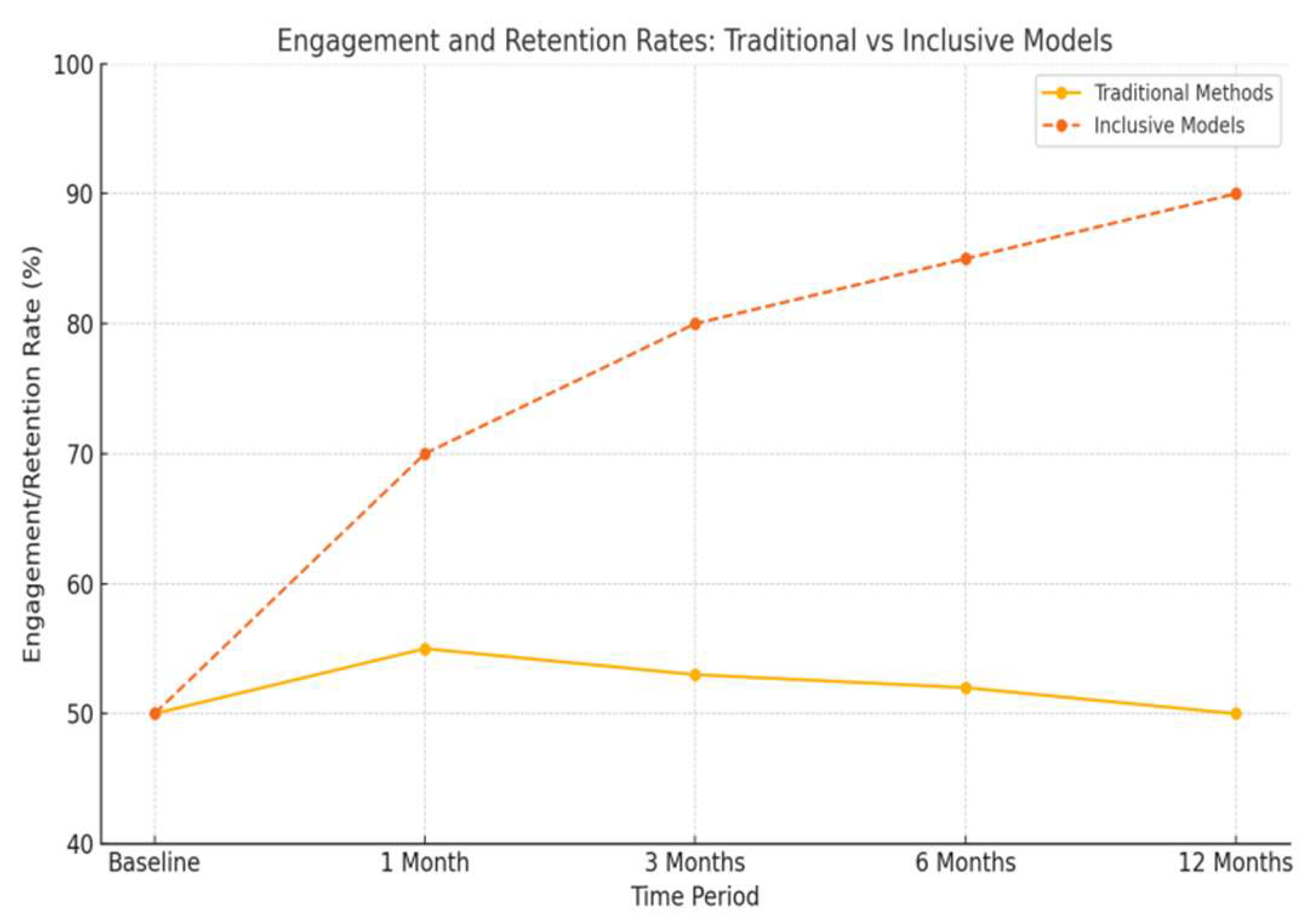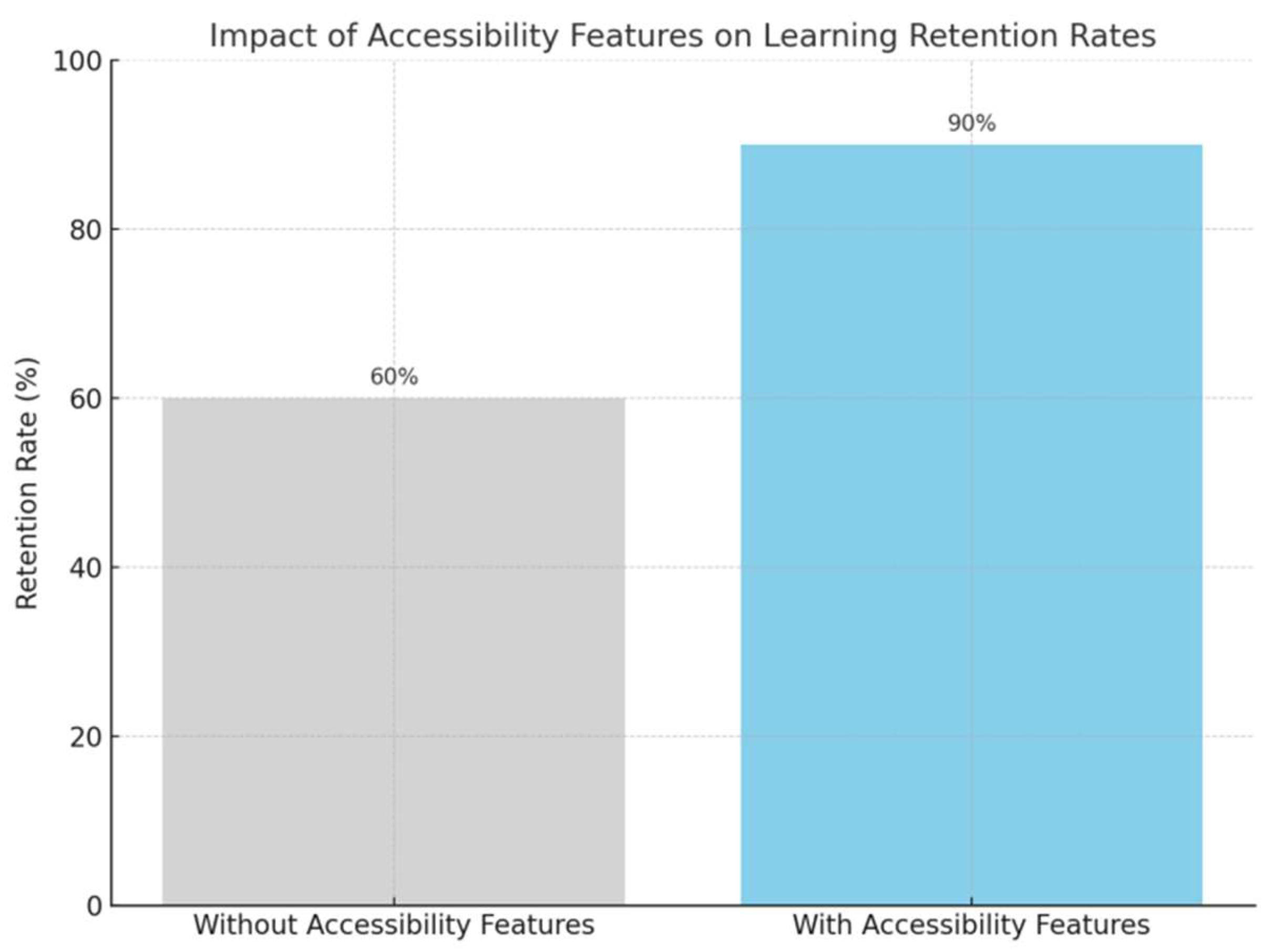Designing for Diversity: Creating Inclusive Digital Learning Environments for Global Classrooms †
Abstract
1. Introduction
- Digital divide: Significant gaps exist between developed and developing nations in terms of internet access and device availability.
- Cultural and linguistic diversity: Language barriers and culturally irrelevant content hinder learner engagement.
- Accessibility for disabled learners: Many digital tools lack features to support students with disabilities.
- Adaptive Technologies: Using AI-powered platforms to personalize learning pathways for each student [4].
- Multilingual content: Offering resources in multiple languages to improve accessibility.
- Cultural relevance: Incorporating local contexts and examples in course material.
- Equitable access: Deploying low-bandwidth solutions and affordable devices for underserved regions.
2. Literature Review
3. Methodology
Case Study: Implementation in Global Classrooms
- Cultural relevance: Localized content tailored to regional contexts [11].
- Accessibility tools: Screen readers, captioning, and interactive assessments for learners with disabilities [12].
- Adaptive learning: AI-driven pathways tailored to individual learning styles [13].
4. Challenges and Limitations
5. Conclusions
Funding
Institutional Review Board Statement
Informed Consent Statement
Data Availability Statement
Acknowledgments
Conflicts of Interest
References
- Borotić, G.; Jagušt, T. Enhancing student engagement with personalized gamification and adaptive learning strategies. In Proceedings of the 2022 IEEE Frontiers in Education Conference (FIE), Uppsala, Sweden, 8–11 October 2022; pp. 1–5. [Google Scholar] [CrossRef]
- Halkiopoulos, C.; Gkintoni, E. Leveraging AI in E-Learning: Personalized Learning and Adaptive Assessment through Cognitive Neuropsychology—A Systematic Analysis. Electronics 2024, 13, 3762. [Google Scholar] [CrossRef]
- Choi, G.W.; Seo, J.Y. Accessibility, Usability, and Universal Design for Learning: Discussion of Three Key LX/UX Elements for Inclusive Learning Design. TechTrends 2024, 68, 936–945. [Google Scholar] [CrossRef]
- Yoon, B. Research Synthesis on Culturally and Linguistically Responsive Teaching for Multilingual Learners. Educ. Sci. 2023, 13, 557. [Google Scholar] [CrossRef]
- Smyth, G. Wireless Technologies Bridging the Digital Divide in Education. In ECEL2006-5th European Conference on e-Learning: ECEL2006; Academic Conference Limited: Reading, UK, 2005; pp. 407–415. [Google Scholar]
- Toyokawa, Y.; Horikoshi, I.; Majumdar, R.; Ogata, H. Challenges and opportunities of AI in inclusive education: A case study of data-enhanced active reading in Japan. Smart Learn. Environ. 2023, 10, 67. [Google Scholar] [CrossRef]
- Friedman, M.; Bryen, D. Web accessibility design recommendations for people with cognitive disabilities. Technol. Disability. 2007, 19, 205–212. [Google Scholar] [CrossRef]
- Leong, W.Y. Fostering Creative Thinking Through Immersive Virtual Reality Environments in Education. Educ. Innov. Emerg. Technol. 2024, 4, 8–25. [Google Scholar]
- Leong, W.Y. Enhancing Academic Integrity in E-Exams Through AI-Driven Proctoring Technologies. In Proceedings of the 14th International Conference on Educational and Information Technology (ICEIT 2025), Guangzhou, China, 14–16 March 2025. [Google Scholar]
- Leong, W.Y. Enhancing Practical Skills Training Through Virtual Reality in TVET Education. In Proceedings of the 2024 International Conference on TVET Excellence & Development (ICTeD), Melaka, Malaysia, 16–17 December 2024. [Google Scholar]
- Gheyssens, E.; Consuegra, E.; Engels, N.; Struyven, K. Creating inclusive classrooms in primary and secondary schools: From noticing to differentiated practices, Teach. Teach. Educ. 2021, 100, 103210. [Google Scholar] [CrossRef]
- Ramdas, S.; Slootman, M.; van der Zee, K. Creating equitable learning environments by building on differences in higher education: Design and implementation of the MIXED model. Learn. Environ. Res. 2025, 1–16. [Google Scholar] [CrossRef]
- Pannullo, L.; Böttinger, T.; Winkelmann, J. Inclusive and Digital Science Education—A Theoretical Framework for Lesson Planning. Educ. Sci. 2025, 15, 148. [Google Scholar] [CrossRef]
- D’Elia, P.; Stalmach, A.; Di Sano, S.; Casale, G. Strategies for inclusive digital education: Problem/project-based learning, cooperative learning, and service learning for students with special educational needs. Front. Educ. 2024, 9, 1447489. [Google Scholar] [CrossRef]
- Okoye, K.; Campos, E.; Das, A.; Chakraborty, V.; Ghosh, M.; Chakrabarti, A.; Hosseini, S. Impact of digitalized-education upon sustainable education and practice: A systematic review and meta-analysis of literature based on pre-intra-and-post pandemic and rural education development. Sustain. Futur. 2025, 10, 100851. [Google Scholar] [CrossRef]
- Castaño-Muñoz, J.; Moreno-Morilla, C.; Reina-Parrado, M.; Lopez-Cobo, I. Unheard voices: Identifying aspects for an inclusive digital education through the lens of low-income contexts schools. Educ. Inf. Technol. 2025, 1–22. [Google Scholar] [CrossRef]
- Cabasan, R.A. Effective Technology Integration: Closing the Digital Gap among High School Students. J. Interdiscip. Perspect. 2024, 2, 397–407. [Google Scholar] [CrossRef]
- González-Betancor, S.M.; López-Puig, A.J.; Cardenal, M.E. Digital inequality at home. The school a compensatory agent. Comput. Educ. 2021, 168, 104195. [Google Scholar] [CrossRef]
- Gottschalk, F.; Weise, C. Digital Equity and Inclusion in Education: An Overview of Practice and Policy in OECD Countries; Organisation for Economic Co-operation and Development—OECD: Paris, France, 2023. [Google Scholar]
- Afzal, A.; Khan, S.; Daud, S.; Ahmad, Z.; Butt, A. Addressing the Digital Divide: Access and use of technology in education. J. Soc. Sci. Rev. 2023, 3, 883–895. [Google Scholar] [CrossRef]
- Wang, C.; Chen, X.; Yu, T.; Liu, Y.; Jing, Y. Education reform and change driven by digital technology: A bibliometric study from a global perspective. Humanit. Soc. Sci. Commun. 2024, 11, 1–17. [Google Scholar] [CrossRef]
- Mascheroni, G.; Cino, D.; Mikuška, J.; Smahel, D. Explaining inequalities in vulnerable children’s digital skills: The effect of individual and social discrimination. New Media Soc. 2022, 24, 437–457. [Google Scholar] [CrossRef]




| Aspect | Traditional Digital Learning | Inclusive Digital Learning |
|---|---|---|
| Content Accessibility | Limited to generic content | Multilingual and adaptive content |
| Engagement Level | Moderate | High |
| Adaptability to Learning Styles | Minimal personalization | Highly personalized with AI |
| Cultural Relevance | Generic content, limited relevance | Localized and culturally relevant |
| Support for Disabilities | Basic or no support | Advanced support (e.g., screen readers, adaptive tools) |
| Learning Outcomes | 60% average retention | 90% average retention |
| Aspect | Traditional | Inclusive |
|---|---|---|
| Content Accessibility | Generic | Adaptive and multilingual |
| Engagement Level | Moderate | High |
| Cultural Relevance | Limited | Highly localized |
| Support for Disabilities | Minimal | Advanced (e.g., AI-powered tools) |
| Metric | Traditional Methods | Inclusive Technologies |
|---|---|---|
| Engagement Rate (%) | 55 | 85 |
| Retention Rate (%) | 60 | 90 |
| User Satisfaction (1–10) | 6.5 | 9.2 |
Disclaimer/Publisher’s Note: The statements, opinions and data contained in all publications are solely those of the individual author(s) and contributor(s) and not of MDPI and/or the editor(s). MDPI and/or the editor(s) disclaim responsibility for any injury to people or property resulting from any ideas, methods, instructions or products referred to in the content. |
© 2025 by the author. Licensee MDPI, Basel, Switzerland. This article is an open access article distributed under the terms and conditions of the Creative Commons Attribution (CC BY) license (https://creativecommons.org/licenses/by/4.0/).
Share and Cite
Leong, W.Y. Designing for Diversity: Creating Inclusive Digital Learning Environments for Global Classrooms. Eng. Proc. 2025, 103, 17. https://doi.org/10.3390/engproc2025103017
Leong WY. Designing for Diversity: Creating Inclusive Digital Learning Environments for Global Classrooms. Engineering Proceedings. 2025; 103(1):17. https://doi.org/10.3390/engproc2025103017
Chicago/Turabian StyleLeong, Wai Yie. 2025. "Designing for Diversity: Creating Inclusive Digital Learning Environments for Global Classrooms" Engineering Proceedings 103, no. 1: 17. https://doi.org/10.3390/engproc2025103017
APA StyleLeong, W. Y. (2025). Designing for Diversity: Creating Inclusive Digital Learning Environments for Global Classrooms. Engineering Proceedings, 103(1), 17. https://doi.org/10.3390/engproc2025103017






